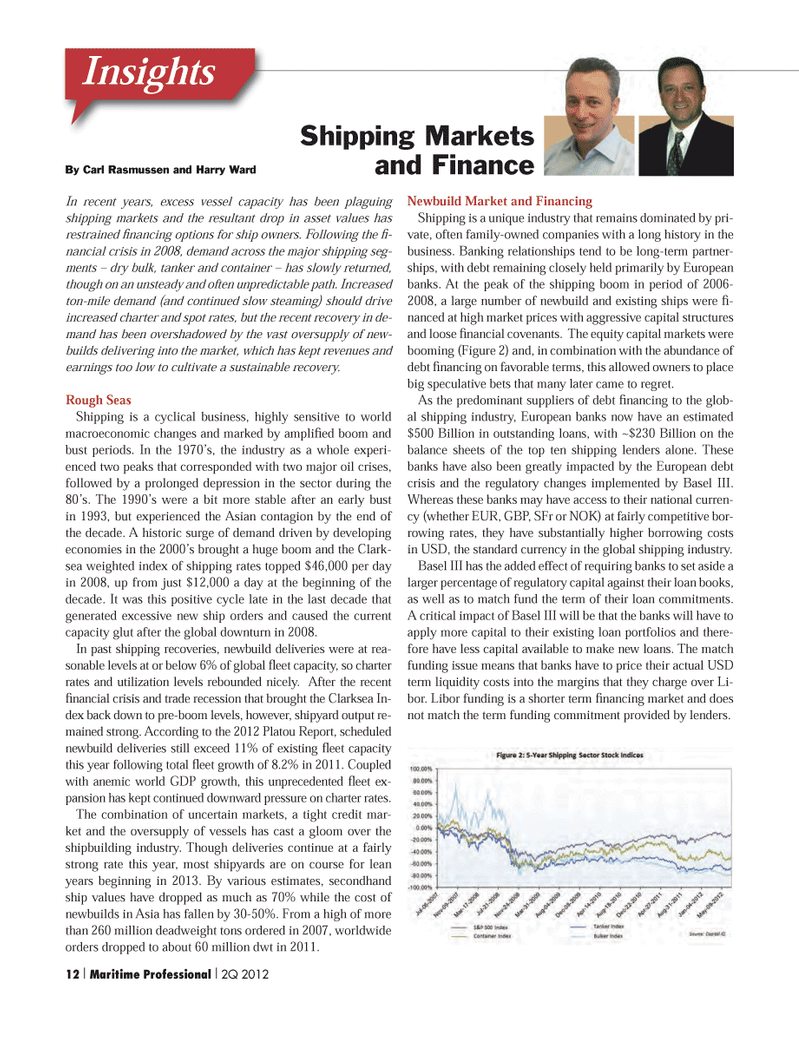
Page 12: of Maritime Logistics Professional Magazine (Q3 2012)
Classification Societies, Quality & Design
Read this page in Pdf, Flash or Html5 edition of Q3 2012 Maritime Logistics Professional Magazine
In recent years, excess vessel capacity has been plaguing shipping markets and the resultant drop in asset values has restrained Þ nancing options for ship owners. Following the Þ -nancial crisis in 2008, demand across the major shipping seg- ments Ð dry bulk, tanker and container Ð has slowly returned, though on an unsteady and often unpredictable path. Increased ton-mile demand (and continued slow steaming) should drive increased charter and spot rates, but the recent recovery in de- mand has been overshadowed by the vast oversupply of new- builds delivering into the market, which has kept revenues and earnings too low to cultivate a sustainable recovery. Rough SeasShipping is a cyclical business, highly sensitive to world macroeconomic changes and marked by ampliÞ ed boom and bust periods. In the 1970Õs, the industry as a whole experi- enced two peaks that corresponded with two major oil crises, followed by a prolonged depression in the sector during the 80Õs. The 1990Õs were a bit more stable after an early bust in 1993, but experienced the Asian contagion by the end of the decade. A historic surge of demand driven by developing economies in the 2000Õs brought a huge boom and the Clark- sea weighted index of shipping rates topped $46,000 per day in 2008, up from just $12,000 a day at the beginning of the decade. It was this positive cycle late in the last decade that generated excessive new ship orders and caused the current capacity glut after the global downturn in 2008. In past shipping recoveries, newbuild deliveries were at rea- sonable levels at or below 6% of global ß eet capacity, so charter rates and utilization levels rebounded nicely. After the recent Þ nancial crisis and trade recession that brought the Clarksea In- dex back down to pre-boom levels, however, shipyard output re- mained strong. According to the 2012 Platou Report, scheduled newbuild deliveries still exceed 11% of existing ß eet capacity this year following total ß eet growth of 8.2% in 2011. Coupled with anemic world GDP growth, this unprecedented ß eet ex- pansion has kept continued downward pressure on charter rates. The combination of uncertain markets, a tight credit mar- ket and the oversupply of vessels has cast a gloom over the shipbuilding industry. Though deliveries continue at a fairly strong rate this year, most shipyards are on course for lean years beginning in 2013. By various estimates, secondhand ship values have dropped as much as 70% while the cost of newbuilds in Asia has fallen by 30-50%. From a high of more than 260 million deadweight tons ordered in 2007, worldwide orders dropped to about 60 million dwt in 2011. Newbuild Market and Financing Shipping is a unique industry that remains dominated by pri-vate, often family-owned companies with a long history in the business. Banking relationships tend to be long-term partner- ships, with debt remaining closely held primarily by European banks. At the peak of the shipping boom in period of 2006- 2008, a large number of newbuild and existing ships were Þ -nanced at high market prices with aggressive capital structures and loose Þ nancial covenants. The equity capital markets were booming (Figure 2) and, in combination with the abundance of debt Þ nancing on favorable terms, this allowed owners to place big speculative bets that many later came to regret. As the predominant suppliers of debt Þ nancing to the glob- al shipping industry, European banks now have an estimated $500 Billion in outstanding loans, with ~$230 Billion on the balance sheets of the top ten shipping lenders alone. These banks have also been greatly impacted by the European debt crisis and the regulatory changes implemented by Basel III. Whereas these banks may have access to their national curren- cy (whether EUR, GBP, SFr or NOK) at fairly competitive bor- rowing rates, they have substantially higher borrowing costs in USD, the standard currency in the global shipping industry. Basel III has the added effect of requiring banks to set aside a larger percentage of regulatory capital against their loan books, as well as to match fund the term of their loan commitments. A critical impact of Basel III will be that the banks will have to apply more capital to their existing loan portfolios and there- fore have less capital available to make new loans. The match funding issue means that banks have to price their actual USD term liquidity costs into the margins that they charge over Li- bor. Libor funding is a shorter term Þ nancing market and does not match the term funding commitment provided by lenders. Shipping Markets and FinanceBy Carl Rasmussen and Harry Ward Insights12 I Maritime Professional I 2Q 2012MP #3 1-17.indd 12MP #3 1-17.indd 128/14/2012 5:04:06 PM8/14/2012 5:04:06 PM

 11
11

 13
13
